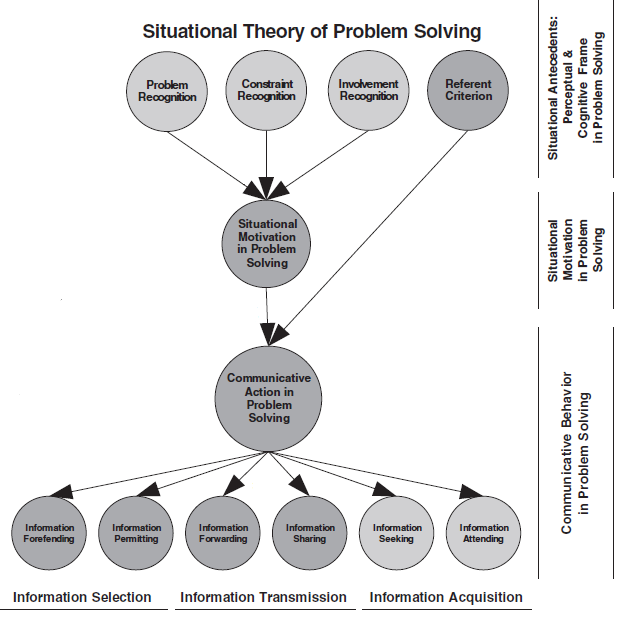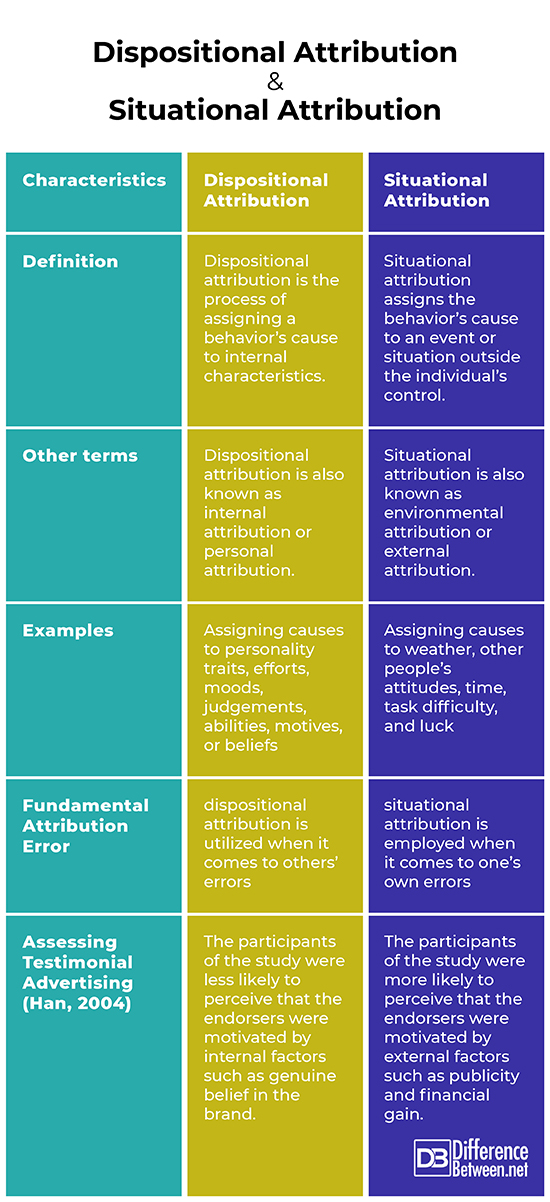Difference Between Dispositional Attribution and Situational Attribution
Attribution theory looks into how individuals explain the causes of events and behaviors. It is concerned with how we utilize various information in arriving at a causal judgment. Fritz Heider, an Austrian psychologist, suggested that behavior is attributed to a combination of external forces (situational attributions), such as fate, task difficulty, and time, and internal forces (dispositional attributions), like attitude and ability. Heider furthered that instead of the actual determinants, it is the perceived determinants that influence behavior. He described humans as amateur psychologists who try judge others’ motives. For instance, if a student perceives that his performance is due to his efforts, he would more likely work harder as compared to if he thinks that it is simply due to luck.
Dispositional and situational attributions are involved in the fundamental attribution error (which will be explained below); also, they both seek to explain the reasons of behaviors. Specifically, dispositional attribution refers to the internal characteristics of an individual; on the other hand, situational attribution pertains to the factors outside the individual’s control. The following discussions further delve into these distinctions.

What is Dispositional Attribution?
Dispositional attribution (also known as internal attribution or personal attribution) is the process of assigning a behavior’s cause to internal characteristics such as personality traits, efforts, moods, judgements, abilities, motives, or beliefs (McLeod, 2012). In this kind of attribution, the person aims to show himself in a positive light (Communication Theory.org). For instance, an employee believes that he was promoted due to his hard work; hence, he believes more in himself and tends to perform better in the future.
In a related study, adult consumers tend to have a higher level of situational attributions as compared to dispositional attributions when it comes to assessing testimonial advertising. The participants of the study were more likely to perceive that the endorsers were motivated by external factors such as publicity and financial gain more than their genuine belief in the brand. Moreover, the researcher found out that dispositional attributions had greater impact on brand evaluations than situational attributions (Han, 2004).

What is Situational Attribution?
Situational attribution (also known as environmental attribution or external attribution) assigns the behavior’s cause to an event or situation outside the individual’s control such as the weather, other people’s attitudes, time, task difficulty, and luck (McLeod, 2012). For instance, an employee who was not promoted believes that it was because of bad luck or because his superior did not simply like him.
In relation to the aforementioned attributions, the fundamental attribution error refers to people’s tendency to attribute other individuals’ negative actions to internal factors while attributing their own negative performances to external factors. Therefore, we tend to cut ourselves a break while holding other people accountable for their actions (Healy, 2017). For instance, when a student was late for class, his excuse was that it was because of the unexpected traffic; on the other hand, when his classmate was late, he believed that it was because his classmate was just lazy.
Difference between Dispositional Attribution and Situational Attribution
Definition
Dispositional attribution is the process of assigning a behavior’s cause to internal characteristics. On the other hand, situational attribution assigns the behavior’s cause to an event or situation outside the individual’s control.
Other terms
Dispositional attribution is also known as internal attribution or personal attribution while situational attribution is also known as environmental attribution or external attribution.
Examples
Examples of dispositional attribution include personality traits, efforts, moods, judgements, abilities, motives, or beliefs. For instance, an employee believes that he was promoted due to his hard work; hence, he believes more in himself and tends to perform better in the future. As for situational attribution, the examples include weather, other people’s attitudes, time, task difficulty, and luck. For instance, an employee who was not promoted believes that it was because of luck or because his superior did not simply like him.
Fundamental Attribution Error
The fundamental attribution error (FAE) refers to people’s tendency to attribute other individuals’ negative actions to internal factors while attributing their own negative performances to external factors. For instance, when a student was late for class, his excuse was that it was because of the unexpected traffic; on the other hand, when his classmate was late, he believed that it was because that classmate was just lazy. Hence, in FAE, dispositional attribution is utilized when it comes to others’ errors while situational attribution is employed when it comes to one’s own errors.
Assessing Testimonial Advertising
In a related study, adult consumers tend to have a higher level of situational attributions as compared to dispositional attributions when it comes to assessing testimonial advertising. The participants of the study were more likely to perceive that the endorsers were motivated by external factors such as publicity and financial gain more than their genuine belief in the brand. Moreover, the researcher found out that dispositional attributions had greater impact on brand evaluations than situational attributions (Han, 2004).
Dispositional Attribution vs Situational Attribution

Summary
- Attribution theory looks into how individuals explain the causes of events and behaviors.
- Dispositional attribution is the process of assigning a behavior’s cause to internal characteristics while situational attribution assigns the behavior’s cause to an event or situation outside the individual’s control.
- Examples of dispositional attribution include assigning causes to personality traits, efforts, moods, judgements, abilities, motives, or beliefs while those of situational attribution include assigning causes to weather, other people’s attitudes, time, task difficulty, and luck.
- Difference Between Hematoma and Melanoma - February 9, 2023
- Difference Between Bruising and Necrosis - February 8, 2023
- Difference Between Brain Hematoma and Brain Hemorrhage - February 8, 2023
Search DifferenceBetween.net :
1 Comment
Leave a Response
References :
[0]Communication Theory.org. Communication theory. https://www.communicationtheory.org/attribution-theory/
[1]Han, K. (2004). The effects of dispositional and situational attributions on evaluative responses to non-celebrity testimonial advertising. University of Georgia. https://getd.libs.uga.edu/pdfs/han_kyoo-hoon_200412_phd.pdf
[2]Healy, P. (2017). The fundamental attribution error. Harvard Business School Online. https://online.hbs.edu/blog/post/the-fundamental-attribution-error
[3]McLeod, S. (2012). Attribution theory. Simply Psychology. https://www.simplypsychology.org/attribution-theory.html
[4]Image credit: https://commons.wikimedia.org/wiki/File:Situational_Theory_of_Problem_Solving.png
[5]Image credit: https://commons.wikimedia.org/wiki/File:Benefits_of_Dispositional_Optimism.png

Such a lucid and a vivid explanation, thank you so much for making it so clear.